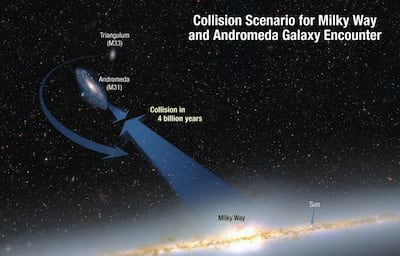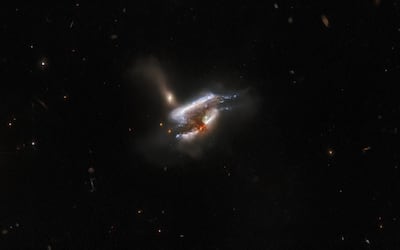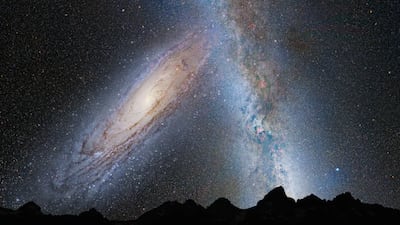Our solar system is expected to face a dramatic transformation because of an impending galactic event that will see a neighbouring galaxy collide with the Milky Way, potentially throwing planets into interplanetary space.
Life on Earth, however, will likely come to an end billions of years before that as the Sun, our life-giving star, becomes too hot for any living organism to survive.
Humans still have plenty of time, though, as these apocalyptic events are projected to unfold over the next five billion years.
Pauline Barmby, chairwoman of the department of physics and astronomy at the Western University in Ontario, Canada, has described what could be left of our solar system once the Andromeda galaxy eventually merges with it.
“A collision between the Milky Way and Andromeda, if it happens, won’t occur all at once,” she told The National.
“Most models of the galaxies’ orbits have them coming in for a close approach some time between five and eight billion years from now, separating for a few billion years, and then finally coalescing.”
The detailed fate of the solar system is not known with certainty, however, because the current orbits of the galaxies are difficult to measure precisely, according to Ms Barmby.
She said the part of the solar system that would most likely be affected by the Milky Way-Andromeda collision would be the Oort Cloud – a distant region of icy objects and comets surrounding the outer edges of the solar system.
“While nearby stars aren’t likely to themselves collide due to the galaxy collision, their orbits will change, and some will likely come near enough that they gravitationally perturb the Oort Cloud’s comets and eject some of them from the solar system,” said Ms Barmby.
Galaxy mergers can take place over hundreds of millions of years as gravitational forces slowly draw them together, distorting their shape and causing star formation, with the full merger process completing over an extended period.
The Sun holds the key
However, it is the dying Sun that could do the most damage to Earth and its neighbouring planets years before the merger.
It is expected to expand into a red giant mass – when it runs out of hydrogen fuel and swells to many times its original size – destroying Mercury and Venus in the process.
“Mars and the other outer planets are expected to survive, although their orbits will expand,” said Ms Barmby.
“Earth’s fate is unclear, because it’s difficult to predict exactly how much mass the Sun will lose in its red giant phase. If Earth is not destroyed, it certainly won’t be habitable.”
The remaining planets might not last much longer either, as they could be thrown out of the solar system entirely after the galaxy collision, when stars passing near the Sun cause gravitational influences between them.
"Over the very long term, 10 to 100 billion years from now, gravitational perturbations from stars passing near the Sun will cause gravitational interactions between the remaining planets - eventually they too will likely be ejected from the solar system," said Ms Barmby.
Dr Nidhal Guessoum, professor of physics and astronomy at the American University of Sharjah, echoed Ms Barmby’s thoughts and said that life on Earth “will have disappeared” well before the merger.
“As the Sun’s power continues to slowly increase it would make life on Earth impossible in about half a billion years from now,” he said.
While it may be a while until our galaxy merges with another, collisions in the universe are quite common, according to Dr Guessoum.
“We have a number of well-known and well-imaged cases of merged, distorted galaxies," she said. “Such mergers, which are due to gravitational pulls between galaxies, often lead to new stars being formed - and most likely new planets around them - by compression of galactic gas and dust.”
Some of the most well-documented galaxy mergers in the universe include the Antennae Galaxies, labelled as NGC 4038/NGC 4039), where two spiral galaxies are merging, creating tidal tails of stars and intense star formation known as a ‘starburst’.
Another example is the Cartwheel Galaxy, formed when a smaller galaxy passes through a larger one, producing a ring structure and triggering waves of star formation.
From Zero
Artist: Linkin Park
Label: Warner Records
Number of tracks: 11
Rating: 4/5
T20 World Cup Qualifier A, Muscat
Friday, February 18: 10am - Oman v Nepal, Canada v Philippines; 2pm - Ireland v UAE, Germany v Bahrain
Saturday, February 19: 10am - Oman v Canada, Nepal v Philippines; 2pm - UAE v Germany, Ireland v Bahrain
Monday, February 21: 10am - Ireland v Germany, UAE v Bahrain; 2pm - Nepal v Canada, Oman v Philippines
Tuesday, February 22: 2pm – semi-finals
Thursday, February 24: 2pm – final
UAE squad: Ahmed Raza (captain), Muhammad Waseem, Chirag Suri, Vriitya Aravind, Rohan Mustafa, Kashif Daud, Zahoor Khan, Alishan Sharafu, Raja Akifullah, Karthik Meiyappan, Junaid Siddique, Basil Hameed, Zafar Farid, Mohammed Boota, Mohammed Usman, Rahul Bhatia
All matches to be streamed live on icc.tv
US PGA Championship in numbers
1 Joost Luiten produced a memorable hole in one at the par-three fourth in the first round.
2 To date, the only two players to win the PGA Championship after winning the week before are Rory McIlroy (2014 WGC-Bridgestone Invitational) and Tiger Woods (2007, WGC-Bridgestone Invitational). Hideki Matsuyama or Chris Stroud could have made it three.
3 Number of seasons without a major for McIlroy, who finished in a tie for 22nd.
4 Louis Oosthuizen has now finished second in all four of the game's major championships.
5 In the fifth hole of the final round, McIlroy holed his longest putt of the week - from 16ft 8in - for birdie.
6 For the sixth successive year, play was disrupted by bad weather with a delay of one hour and 43 minutes on Friday.
7 Seven under par (64) was the best round of the week, shot by Matsuyama and Francesco Molinari on Day 2.
8 Number of shots taken by Jason Day on the 18th hole in round three after a risky recovery shot backfired.
9 Jon Rahm's age in months the last time Phil Mickelson missed the cut in the US PGA, in 1995.
10 Jimmy Walker's opening round as defending champion was a 10-over-par 81.
11 The par-four 11th coincidentally ranked as the 11th hardest hole overall with a scoring average of 4.192.
12 Paul Casey was a combined 12 under par for his first round in this year's majors.
13 The average world ranking of the last 13 PGA winners before this week was 25. Kevin Kisner began the week ranked 25th.
14 The world ranking of Justin Thomas before his victory.
15 Of the top 15 players after 54 holes, only Oosthuizen had previously won a major.
16 The par-four 16th marks the start of Quail Hollow's so-called "Green Mile" of finishing holes, some of the toughest in golf.
17 The first round scoring average of the last 17 major champions was 67.2. Kisner and Thorbjorn Olesen shot 67 on day one at Quail Hollow.
18 For the first time in 18 majors, the eventual winner was over par after round one (Thomas shot 73).
White hydrogen: Naturally occurring hydrogen
Chromite: Hard, metallic mineral containing iron oxide and chromium oxide
Ultramafic rocks: Dark-coloured rocks rich in magnesium or iron with very low silica content
Ophiolite: A section of the earth’s crust, which is oceanic in nature that has since been uplifted and exposed on land
Olivine: A commonly occurring magnesium iron silicate mineral that derives its name for its olive-green yellow-green colour
About Okadoc
Date started: Okadoc, 2018
Founder/CEO: Fodhil Benturquia
Based: Dubai, UAE
Sector: Healthcare
Size: (employees/revenue) 40 staff; undisclosed revenues recording “double-digit” monthly growth
Funding stage: Series B fundraising round to conclude in February
Investors: Undisclosed
The%20specs
%3Cp%3E%3Cstrong%3EEngine%3A%20%3C%2Fstrong%3E2.0-litre%20four-cylinder%20turbo%20hybrid%0D%3Cbr%3E%3Cstrong%3EPower%3A%20%3C%2Fstrong%3E680hp%0D%3Cbr%3E%3Cstrong%3ETorque%3A%20%3C%2Fstrong%3E1%2C020Nm%0D%3Cbr%3E%3Cstrong%3ETransmission%3A%20%3C%2Fstrong%3E9-speed%20auto%0D%3Cbr%3E%3Cstrong%3EFuel%20consumption%3A%20%3C%2Fstrong%3E7.5L%2F100km%0D%3Cbr%3E%3Cstrong%3EOn%20sale%3A%20%3C%2Fstrong%3EEarly%202024%0D%3Cbr%3E%3Cstrong%3EPrice%3A%20%3C%2Fstrong%3EFrom%20Dh530%2C000%20(estimate)%3C%2Fp%3E%0A
German intelligence warnings
- 2002: "Hezbollah supporters feared becoming a target of security services because of the effects of [9/11] ... discussions on Hezbollah policy moved from mosques into smaller circles in private homes." Supporters in Germany: 800
- 2013: "Financial and logistical support from Germany for Hezbollah in Lebanon supports the armed struggle against Israel ... Hezbollah supporters in Germany hold back from actions that would gain publicity." Supporters in Germany: 950
- 2023: "It must be reckoned with that Hezbollah will continue to plan terrorist actions outside the Middle East against Israel or Israeli interests." Supporters in Germany: 1,250
Source: Federal Office for the Protection of the Constitution
More from Rashmee Roshan Lall
Tightening the screw on rogue recruiters
The UAE overhauled the procedure to recruit housemaids and domestic workers with a law in 2017 to protect low-income labour from being exploited.
Only recruitment companies authorised by the government are permitted as part of Tadbeer, a network of labour ministry-regulated centres.
A contract must be drawn up for domestic workers, the wages and job offer clearly stating the nature of work.
The contract stating the wages, work entailed and accommodation must be sent to the employee in their home country before they depart for the UAE.
The contract will be signed by the employer and employee when the domestic worker arrives in the UAE.
Only recruitment agencies registered with the ministry can undertake recruitment and employment applications for domestic workers.
Penalties for illegal recruitment in the UAE include fines of up to Dh100,000 and imprisonment
But agents not authorised by the government sidestep the law by illegally getting women into the country on visit visas.
SPAIN SQUAD
Goalkeepers Simon (Athletic Bilbao), De Gea (Manchester United), Sanchez (Brighton)
Defenders Gaya (Valencia), Alba (Barcelona), P Torres (Villarreal), Laporte (Manchester City), Garcia (Manchester City), D Llorente (Leeds), Azpilicueta (Chelsea)
Midfielders Busquets (Barcelona), Rodri (Manchester City), Pedri (Barcelona), Thiago (Liverpool), Koke (Atletico Madrid), Ruiz (Napoli), M Llorente (Atletico Madrid)
Forwards: Olmo (RB Leipzig), Oyarzabal (Real Sociedad), Morata (Juventus), Moreno (Villarreal), F Torres (Manchester City), Traore (Wolves), Sarabia (PSG)
You may remember …
Robbie Keane (Atletico de Kolkata) The Irish striker is, along with his former Spurs teammate Dimitar Berbatov, the headline figure in this season’s ISL, having joined defending champions ATK. His grand entrance after arrival from Major League Soccer in the US will be delayed by three games, though, due to a knee injury.
Dimitar Berbatov (Kerala Blasters) Word has it that Rene Meulensteen, the Kerala manager, plans to deploy his Bulgarian star in central midfield. The idea of Berbatov as an all-action, box-to-box midfielder, might jar with Spurs and Manchester United supporters, who more likely recall an always-languid, often-lazy striker.
Wes Brown (Kerala Blasters) Revived his playing career last season to help out at Blackburn Rovers, where he was also a coach. Since then, the 23-cap England centre back, who is now 38, has been reunited with the former Manchester United assistant coach Meulensteen, after signing for Kerala.
Andre Bikey (Jamshedpur) The Cameroonian defender is onto the 17th club of a career has taken him to Spain, Portugal, Russia, the UK, Greece, and now India. He is still only 32, so there is plenty of time to add to that tally, too. Scored goals against Liverpool and Chelsea during his time with Reading in England.
Emiliano Alfaro (Pune City) The Uruguayan striker has played for Liverpool – the Montevideo one, rather than the better-known side in England – and Lazio in Italy. He was prolific for a season at Al Wasl in the Arabian Gulf League in 2012/13. He returned for one season with Fujairah, whom he left to join Pune.
The specs
Engine: 3.9-litre twin-turbo V8
Transmission: seven-speed
Power: 720hp
Torque: 770Nm
Price: Dh1,100,000
On sale: now
Groom and Two Brides
Director: Elie Semaan
Starring: Abdullah Boushehri, Laila Abdallah, Lulwa Almulla
Rating: 3/5
Star%20Wars%3A%20Episode%20I%20%E2%80%93%20The%20Phantom%20Menace
%3Cp%3E%3Cstrong%3EDeveloper%3A%3C%2Fstrong%3E%20Big%20Ape%20Productions%3Cbr%3E%3Cstrong%3EPublisher%3A%3C%2Fstrong%3E%20LucasArts%3Cbr%3E%3Cstrong%3EConsoles%3A%3C%2Fstrong%3E%20PC%2C%20PlayStation%3Cbr%3E%3Cstrong%3ERating%3A%3C%2Fstrong%3E%202%2F5%3C%2Fp%3E%0A
The Vile
Starring: Bdoor Mohammad, Jasem Alkharraz, Iman Tarik, Sarah Taibah
Director: Majid Al Ansari
Rating: 4/5
SPECS
%3Cp%3EEngine%3A%20Supercharged%203.5-litre%20V6%0D%3Cbr%3EPower%3A%20400hp%0D%3Cbr%3ETorque%3A%20430Nm%0D%3Cbr%3EOn%20sale%3A%20Now%0D%3Cbr%3EPrice%3A%20From%20Dh450%2C000%0D%3Cbr%3E%3C%2Fp%3E%0A
At a glance
- 20,000 new jobs for Emiratis over three years
- Dh300 million set aside to train 18,000 jobseekers in new skills
- Managerial jobs in government restricted to Emiratis
- Emiratis to get priority for 160 types of job in private sector
- Portion of VAT revenues will fund more graduate programmes
- 8,000 Emirati graduates to do 6-12 month replacements in public or private sector on a Dh10,000 monthly wage - 40 per cent of which will be paid by government
AI traffic lights to ease congestion at seven points to Sheikh Zayed bin Sultan Street
The seven points are:
Shakhbout bin Sultan Street
Dhafeer Street
Hadbat Al Ghubainah Street (outbound)
Salama bint Butti Street
Al Dhafra Street
Rabdan Street
Umm Yifina Street exit (inbound)
Kibsons%20Cares
%3Cp%3E%3Cstrong%3ERecycling%3Cbr%3E%3C%2Fstrong%3EAny%20time%20you%20receive%20a%20Kibsons%20order%2C%20you%20can%20return%20your%20cardboard%20box%20to%20the%20drivers.%20They%E2%80%99ll%20be%20happy%20to%20take%20it%20off%20your%20hands%20and%20ensure%20it%20gets%20reused%3C%2Fp%3E%0A%3Cp%3E%3Cstrong%3EKind%20to%20health%20and%20planet%3C%2Fstrong%3E%3Cbr%3ESolar%20%E2%80%93%2025-50%25%20of%20electricity%20saved%3Cbr%3EWater%20%E2%80%93%2075%25%20of%20water%20reused%3Cbr%3EBiofuel%20%E2%80%93%20Kibsons%20fleet%20to%20get%2020%25%20more%20mileage%20per%20litre%20with%20biofuel%20additives%3C%2Fp%3E%0A%3Cp%3E%3Cstrong%3ESustainable%20grocery%20shopping%3C%2Fstrong%3E%3Cbr%3ENo%20antibiotics%3Cbr%3ENo%20added%20hormones%3Cbr%3ENo%20GMO%3Cbr%3ENo%20preservatives%3Cbr%3EMSG%20free%3Cbr%3E100%25%20natural%3C%2Fp%3E%0A
Abu Dhabi traffic facts
Drivers in Abu Dhabi spend 10 per cent longer in congested conditions than they would on a free-flowing road
The highest volume of traffic on the roads is found between 7am and 8am on a Sunday.
Travelling before 7am on a Sunday could save up to four hours per year on a 30-minute commute.
The day was the least congestion in Abu Dhabi in 2019 was Tuesday, August 13.
The highest levels of traffic were found on Sunday, November 10.
Drivers in Abu Dhabi lost 41 hours spent in traffic jams in rush hour during 2019
Tips from the expert
Dobromir Radichkov, chief data officer at dubizzle and Bayut, offers a few tips for UAE residents looking to earn some cash from pre-loved items.
- Sellers should focus on providing high-quality used goods at attractive prices to buyers.
- It’s important to use clear and appealing photos, with catchy titles and detailed descriptions to capture the attention of prospective buyers.
- Try to advertise a realistic price to attract buyers looking for good deals, especially in the current environment where consumers are significantly more price-sensitive.
- Be creative and look around your home for valuable items that you no longer need but might be useful to others.
The%20specs
%3Cp%3E%3Cstrong%3EEngine%3A%3C%2Fstrong%3E%20Dual%20synchronous%20electric%20motors%0D%3Cbr%3E%3Cstrong%3EPower%3A%20%3C%2Fstrong%3E660hp%0D%3Cbr%3E%3Cstrong%3ETorque%3A%20%3C%2Fstrong%3E1%2C100Nm%0D%3Cbr%3E%3Cstrong%3ETransmission%3A%20%3C%2Fstrong%3ESingle-speed%20automatic%0D%3Cbr%3E%3Cstrong%3ETouring%20range%3A%20%3C%2Fstrong%3E488km-560km%0D%3Cbr%3E%3Cstrong%3EPrice%3A%20%3C%2Fstrong%3EFrom%20Dh850%2C000%20(estimate)%0D%3Cbr%3E%3Cstrong%3EOn%20sale%3A%20%3C%2Fstrong%3EOctober%3C%2Fp%3E%0A
Our family matters legal consultant
Name: Hassan Mohsen Elhais
Position: legal consultant with Al Rowaad Advocates and Legal Consultants.
South Africa v India schedule
Tests: 1st Test Jan 5-9, Cape Town; 2nd Test Jan 13-17, Centurion; 3rd Test Jan 24-28, Johannesburg
ODIs: 1st ODI Feb 1, Durban; 2nd ODI Feb 4, Centurion; 3rd ODI Feb 7, Cape Town; 4th ODI Feb 10, Johannesburg; 5th ODI Feb 13, Port Elizabeth; 6th ODI Feb 16, Centurion
T20Is: 1st T20I Feb 18, Johannesburg; 2nd T20I Feb 21, Centurion; 3rd T20I Feb 24, Cape Town
COMPANY%20PROFILE
%3Cp%3E%3Cstrong%3EName%3A%3C%2Fstrong%3E%20PlanRadar%3Cbr%3E%3Cstrong%3EStarted%3A%20%3C%2Fstrong%3E2013%3Cbr%3E%3Cstrong%3ECo-founders%3A%20%3C%2Fstrong%3EIbrahim%20Imam%2C%20Sander%20van%20de%20Rijdt%2C%20Constantin%20K%C3%B6ck%2C%20Clemens%20Hammerl%2C%20Domagoj%20Dolinsek%3Cbr%3E%3Cstrong%3EBased%3A%20%3C%2Fstrong%3EVienna%2C%20Austria%3Cbr%3E%3Cstrong%3ESector%3A%20%3C%2Fstrong%3EConstruction%20and%20real%20estate%3Cbr%3E%3Cstrong%3ECurrent%20number%20of%20staff%3A%20%3C%2Fstrong%3E400%2B%3Cbr%3E%3Cstrong%3EInvestment%20stage%3A%20%3C%2Fstrong%3ESeries%20B%3Cbr%3E%3Cstrong%3EInvestors%3A%3C%2Fstrong%3E%20Headline%2C%20Berliner%20Volksbank%20Ventures%2C%20aws%20Gr%C3%BCnderfonds%2C%20Cavalry%20Ventures%2C%20Proptech1%2C%20Russmedia%2C%20GR%20Capital%3C%2Fp%3E%0A
Our family matters legal consultant
Name: Hassan Mohsen Elhais
Position: legal consultant with Al Rowaad Advocates and Legal Consultants.
Sole survivors
- Cecelia Crocker was on board Northwest Airlines Flight 255 in 1987 when it crashed in Detroit, killing 154 people, including her parents and brother. The plane had hit a light pole on take off
- George Lamson Jr, from Minnesota, was on a Galaxy Airlines flight that crashed in Reno in 1985, killing 68 people. His entire seat was launched out of the plane
- Bahia Bakari, then 12, survived when a Yemenia Airways flight crashed near the Comoros in 2009, killing 152. She was found clinging to wreckage after floating in the ocean for 13 hours.
- Jim Polehinke was the co-pilot and sole survivor of a 2006 Comair flight that crashed in Lexington, Kentucky, killing 49.
Killing of Qassem Suleimani
Zayed Sustainability Prize
Director: Laxman Utekar
Cast: Vicky Kaushal, Akshaye Khanna, Diana Penty, Vineet Kumar Singh, Rashmika Mandanna
Rating: 1/5
Blackpink World Tour [Born Pink] In Cinemas
Starring: Rose, Jisoo, Jennie, Lisa
Directors: Min Geun, Oh Yoon-Dong
Rating: 3/5
Honeymoonish
%3Cp%3E%3Cstrong%3EDirector%3A%3C%2Fstrong%3E%20Elie%20El%20Samaan%3C%2Fp%3E%0A%3Cp%3E%3Cstrong%3EStarring%3A%20%3C%2Fstrong%3ENour%20Al%20Ghandour%2C%20Mahmoud%20Boushahri%3C%2Fp%3E%0A%3Cp%3E%3Cstrong%3ERating%3A%3C%2Fstrong%3E%203%2F5%3C%2Fp%3E%0A
HWJN
%3Cp%3EDirector%3A%20Yasir%20Alyasiri%3C%2Fp%3E%0A%3Cp%3EStarring%3A%20Baraa%20Alem%2C%20Nour%20Alkhadra%2C%20Alanoud%20Saud%3C%2Fp%3E%0A%3Cp%3ERating%3A%203%2F5%3C%2Fp%3E%0A%3Cp%3E%3C%2Fp%3E%0A




